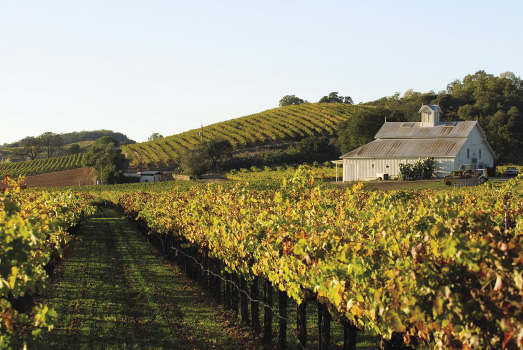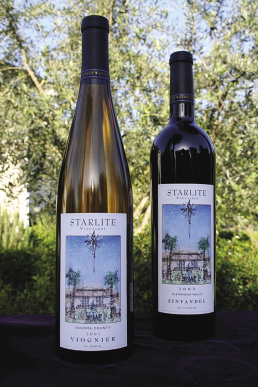


![]()
ONLINE
Creating European-Style Wines
Editors’ Note
Arman Pahlavan was born in Tehran, Iran and moved with his family to the U.S. He graduated with a B.A. from UC Berkeley, and attended UC Hastings College of the Law from 1988 to 1991. His last job before graduate school was as a maître d’ at Stars Restaurant in San Francisco. He is a Partner at Squire Sanders, focusing his legal career in private equity and technology. He and Rina Pedroza-Pahlavan, his business partner, purchased the vineyards at their estate in Geyserville, California in 2001, and founded Starlite Vineyards in 2003. Their mutual passion for Starlite Vineyards has kept them running the boutique family wine business that they hope to turn into a legacy for their younger generation.
Vineyard Brief
Starlite Vineyards (www.starlitevineyards.com) is an ultra-premium boutique winery and estate located in Sonoma County’s famed Alexander Valley. They commenced their winemaking journey with the Zinfandel that was already planted in the estate’s vineyards. They defined their elegant and soft, yet well-balanced, style of Zinfandel with an inaugural vintage in 2003, and have maintained a consistent quality and character with subsequent vintages. In 2007, they expanded the winery’s offering to include Viognier and Cabernet Sauvignon. The Viognier has received acclaim from the sommelier community as one of the most beautiful expressions of that varietal from California. Their Cabernet Sauvignon was released in 2011, and has been hailed as an elegant and European-style wine.
What makes this brand so special, and what has afforded you the opportunity to grow as you have?
I had a vision to create a brand that would be around for the next 30 years so it would become something I could work at until I retire.
It takes years for consumer products to really own a brand and become a name that is recognized. We have accomplished this, although we initially did this at a slow pace.
We started by studying the vineyard ahead of time, while the property was under contract with another winery. I felt that there could be a chance for a brand that would create a style of wine that is not typical today. The U.S. style of wine is focused on very ripe fruits; I wanted to focus on creating a softer, more elegant style of wine that would come from a process more akin to the European style of winemaking.

Starlite Vineyards
But it’s one thing to think about doing it and another to produce wines like this. We were fortunate to pair up with a fabulous winemaker to launch the project. She was focused on the well-balanced and softer style that we would be comfortable producing.
It was about creating the right mouth feel with our Zinfandel so it would represent a European style of winemaking, because it’s typically not a wine that’s produced this way. But I felt that any grape can make a style of wine to fit what one’s palate desires.
This is why we tried to make what we refer to as the “claret” of Zinfandels as our first wine – it’s a lighter style with more layers of subtle fruits; it’s also elegant with a softer tannic palate, yet still complex in structure with a remarkable long finish, and it has a high level of acidity which makes it an ideal food-pairing wine. We then carried that feel throughout the rest of the wines we make.
With the Cabernet Sauvignon, we tried to make a European style akin to the Spanish and French styles.
As we’ve evolved, we have succeeded in keeping the focus on creating a more European style of wines – lighter in terms of palates and softer in terms of structure, and it has actually worked out well.
Is it challenging to be accepted in this industry when you’re approaching it from a unique angle?
It’s doable, but you have to figure out how to approach it. Initially, I brought the wines to the New York market; every one of our wines will be brought to the New York market to test and launch.
The New York market is made up mostly of the sommeliers of all of the top restaurants. Most of them are European, so our style of wine is something they grew up with. They have enjoyed many of our wines – our Viognier, for instance, is well received by the sommeliers because they know how difficult Viognier grapes are to farm, and how challenging the wine is to make due to the varietal’s innately low acidity when you crush the grapes. Similarly, our Zinfandel has been hailed as having the longest finish, which allows versatile food pairing and the ability to carry a five-course meal. So gaining acceptance is difficult, but if you approach it correctly, it’s very easy to prove that you know what you’re doing.
It is tough to be accepted as a young winery because it’s difficult to prove you can create something so extraordinary in style that is consistent over time. But you will find the right consumer markets if you produce a high-quality wine that has a consistent view about its style. It may not be perfect for everybody, but there are enough different wine palates that you will be able to find people who appreciate the wine, especially if you take the time to educate them about it.
People come to our property and engage in discussions with us so we can explain to them what we’re producing, and why our wines can be enjoyed by a normal consumer – not just by a sommelier with a trained palate.

Starlite Viognier and Zinfandel
How can you invest in consistency and quality and keep price reasonable?
The consistency is key, and we have remained consistent by limiting what we’re producing. Once you expand what you do, you will run afoul with quality controls. I may be a contrarian in this respect, but I believe this philosophy is true. There are a lot of fantastic winemakers that produce 10,000 to 15,000 cases of wine. But, even for them, their darling wine is a vineyard designate that produces less than 500 cases.
Consistency comes from having the fruit coming from our estates, as opposed to going and buying fruits; it comes from having proprietors involved continuously in overseeing all operations including the farming, vinification, branding, and marketing, as well as being directly involved with the sale of the wine to the consumers at the winery; it comes from caring about the vision as opposed to changing it based on the financial ups and downs of the markets.
A lot of larger wineries have to produce because they have a larger overhead.
We can, however, in any particular year, say that we’re not going to produce the Cabernet because the growing season and/or harvest results were not favorable enough to meet our production standards for our ultra-premium wines.
Another difference from the large wineries is that if we have too much inventory, we don’t have to drop the price in the markets to sell it to make sure we have enough cash flow to survive.•